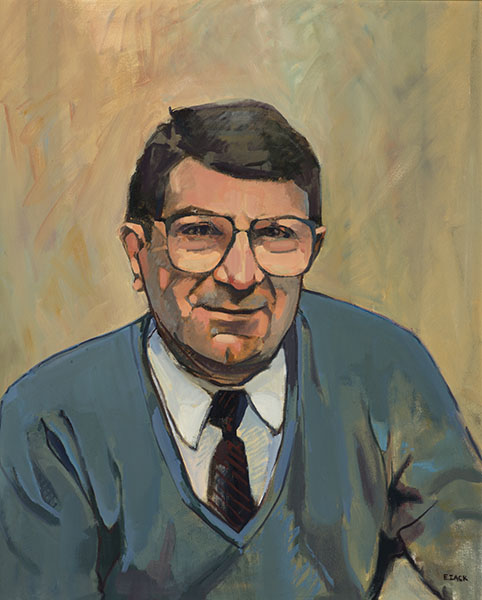Ruben Adler

Ruben Adler
- Artist:
- Elizabeth Zack
- Date:
- circa 2011
- Medium:
- Oil on canvas
- Dimensions:
- 29.25 x 23.25 in.
Ruben Adler
1940-2007
Adler, a director of the Wilmer Eye Institute’s Retinal Degeneration Center, was born in Los Toldos, Argentina. Following the career path of his physician father, he graduated from the Universidad de Buenos Aires in 1963. From 1964 to 1966, Adler served as an Internal Fellow at the National Research Council of Argentina before doing further training from 1968 to 1969 as an External Fellow at the Hubrecht Laboratory in Utrecht. Adler returned to Agentina in 1970 as Assistant Professor of Histology, Cytology and Embryology at the Universidad de Buenos Aires.
In the 1970s, the military dictatorship of Argentina became more ruthless. After several of his friends disappeared, and he and his family were personally threatened, Adler received a John Simon Guggenheim Memorial Fellowship at the University of California, San Diego in 1977 and moved to the United States. Adler focused his research efforts on the identification of a trophic factor from the ciliary ganglion that promoted neuronal growth and survival in vitro and which led to an impressive series of publications culminating in the discovery of ciliary neurotrophic factor (CNTF).
In 1982, Arnall Patz recruited Adler into a new Retinal Degeneration Research Center at Johns Hopkins supported by the Foundation Fighting Blindness. Here, he developed tissue culture methods for retinal photoreceptors from which the concept of a default pathway for photoreceptor development emerged. He published 151 articles, reviews, and chapters which led to his promotion to professor in 1991 and the receipt of the Arnall Patz Distinguished Professorship of Ophthalmology in 1993.
During his career, Adler supported his research with grants from both federal agencies and private foundations. At the time of his death, he was the principal investigator on two research grants from the National Eye Institute (NEI), was the Director of a Visual Neuroscience Training Grant from the National Eye Institute, and held a research grant from the Foundation Fighting Blindness. One of his NEI grants awarded shortly after his move to Hopkins received over twenty-four years of continuous funding.
"*" indicates required fields
